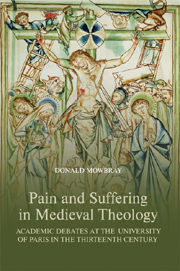 Pain and Suffering in Medieval Theology
Pain and Suffering in Medieval Theology Book contents
- Frontmatter
- Contents
- Acknowledgements
- Abbreviations
- Dedication
- Introduction
- 1 Thirteenth-Century Theological Ideas about Human Pain and Suffering and the Passion of Christ
- 2 Gendering Pain: Theological Ideas about Female and Male Suffering
- 3 Pain as a Restorative Power: Voluntary Suffering and Satisfaction for Sin
- 4 The Intellectual Development of Limbo: Pain, Children and Original Sin
- 5 Anima Separata: Masters of Theology and the Controversy surrounding the Suffering of the Separated Soul
- 6 Defining the Corporeal: Suffering in Hell according to Masters of Theology at Paris, c.1230–c.1280
- Conclusion
- Select Bibliography
- Index
- Frontmatter
- Contents
- Acknowledgements
- Abbreviations
- Dedication
- Introduction
- 1 Thirteenth-Century Theological Ideas about Human Pain and Suffering and the Passion of Christ
- 2 Gendering Pain: Theological Ideas about Female and Male Suffering
- 3 Pain as a Restorative Power: Voluntary Suffering and Satisfaction for Sin
- 4 The Intellectual Development of Limbo: Pain, Children and Original Sin
- 5 Anima Separata: Masters of Theology and the Controversy surrounding the Suffering of the Separated Soul
- 6 Defining the Corporeal: Suffering in Hell according to Masters of Theology at Paris, c.1230–c.1280
- Conclusion
- Select Bibliography
- Index
Summary
Ideas about pain and suffering were developed by masters of theology into a coherent technical language supported by a conceptual framework, which helped them to elucidate important areas of discussion within their theological treatises. This was achieved in various ways: the attention to and interpretation of a discrete group of biblical, classical and patristic authorities; their use of new theories which affected theology; and the framing of specific questions about pain and suffering within important areas of theology concerned with this life and the afterlife. The language which the masters developed was common to a variety of contexts within their theological debates.
The authorities which the masters used during theological debate provided the skeletal frame upon which they developed their ideas about pain. Part of any theologian's profession was to resolve the differences which were present in his main authorities. In this way, when masters asked questions about pain and suffering, they were obliged to consider what authorities had stated previously. This was seen, for example, in relation to the development of limbo. As with other areas of development within their conceptual framework of pain, the masters reinterpreted the beliefs of Augustine in order to deny that unbaptised children were eternally damned, whilst, in other respects, they were able to maintain allegiance to one of their key patristic authorities. However, the masters also employed their authorities in a way which helped them develop their language of suffering more exactly.
- Type
- Chapter
- Information
- Pain and Suffering in Medieval TheologyAcademic Debates at the University of Paris in the Thirteenth Century, pp. 159 - 164Publisher: Boydell & BrewerPrint publication year: 2009


